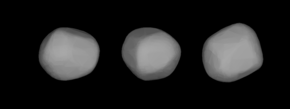423 Diotima
 A three-dimensional model of 423 Diotima based on its light curve | |
| Discovery | |
|---|---|
| Discovered by | Auguste Charlois |
| Discovery date | 7 December 1896 |
| Designations | |
| (423) Diotima | |
| Pronunciation | /daɪ.əˈtaɪmə/[1] |
Named after | Diotima of Mantinea (Διοτίμα Diotīma) |
| 1896 DB | |
| Main belt | |
| Adjectives | Diotimean /daɪ.ɒtəˈmiːən/, Diotimian /daɪ.əˈtɪmiən/ |
| Orbital characteristics[2] | |
| Epoch 31 July 2016 (JD 2457600.5) | |
| Uncertainty parameter 0 | |
| Observation arc | 116.96 yr (42719 d) |
| Aphelion | 3.18523 AU (476.504 Gm) |
| Perihelion | 2.95026 AU (441.353 Gm) |
| 3.06774 AU (458.927 Gm) | |
| Eccentricity | 0.038297 |
| 5.37 yr (1962.6 d) | |
| 237.495° | |
| 0° 11m 0.355s / day | |
| Inclination | 11.2304° |
| 69.4710° | |
| 200.103° | |
| Physical characteristics | |
| Dimensions | 171 km × 138 km[3] |
| 175.859±3.854 km[2] 211.64 ± 16.02 km[4] | |
| Mass | (6.91±1.93)×1018 kg[4] (4.368 ± 1.680/1.377)×1018 kg[5] |
Mean density | 1.39 ± 0.50 g/cm3[4] 1.534 ± 0.590/0.483 g/cm3[5] |
| 4.775 h (0.1990 d)[2] | |
| 0.067±0.015[2] | |
| C[2] | |
| 7.42[2] | |
423 Diotima is one of the larger main-belt asteroids. It is classified as a C-type asteroid[2] and is probably composed of primitive carbonaceous material.
It was discovered by Auguste Charlois on 7 December 1896, in Nice. In the late 1990s, a network of astronomers worldwide gathered lightcurve data that was ultimately used to derive the spin states and shape models of 10 new asteroids, including 423 Diotima. The light curve for this asteroid varies "a lot" depending on the position, with the brightness variations ranging from almost zero to up to 0.2 in magnitude.[6][7] Dunham (2002) used 15 chords and obtained an estimated size of 171 km × 138 km.[3]
Name
[edit]Diotima is named for Diotima of Mantinea, a priestess who was one of Socrates's teachers. It is one of seven of Charlois's discoveries that was expressly named by the Astromomisches Rechen-Institut (Astronomical Calculation Institute).[8]
The name is stressed on the penultimate syllable, /daɪ.əˈtaɪmə/ dy-ə-TY-mə, as in Latin Diotīma.
References
[edit]- ^ Noah Webster (1884) A Practical Dictionary of the English Language
- ^ a b c d e f g "JPL Small-Body Database Browser: 423 Diotima (1896 DB)" (2008-09-09 last obs). Retrieved 6 May 2016.
- ^ a b Vasundhara, R; Kuppuswamy, Ramamoorthy; Velu, Venkataramana (2006). "Occultation of 2UCAC 42376428 by (423) Diotima on 2005 March 06". Astronomical Society of India. 34: 21–26. Retrieved 30 November 2008.
- ^ a b c Carry, B. (December 2012), "Density of asteroids", Planetary and Space Science, 73 (1): 98–118, arXiv:1203.4336, Bibcode:2012P&SS...73...98C, doi:10.1016/j.pss.2012.03.009. See Table 1.
- ^ a b Fienga, A.; Avdellidou, C.; Hanuš, J. (February 2020). "Asteroid masses obtained with INPOP planetary ephemerides". Monthly Notices of the Royal Astronomical Society. 492 (1). doi:10.1093/mnras/stz3407.
- ^ Durech, J.; et al. (April 2007), "Physical models of ten asteroids from an observers' collaboration network", Astronomy and Astrophysics, 465 (1): 331–337, Bibcode:2007A&A...465..331D, doi:10.1051/0004-6361:20066347.
- ^ Durech, J.; Kaasalainen, M.; Marciniak, A.; Allen, W. H. et al. "Asteroid brightness and geometry," Astronomy and Astrophysics, Volume 465, Issue 1, April I 2007, pp. 331-337.
- ^ Schmadel Lutz D. Dictionary of Minor Planet Names (fifth edition), Springer, 2003. ISBN 3-540-00238-3.
External links
[edit]- 423 Diotima at AstDyS-2, Asteroids—Dynamic Site
- 423 Diotima at the JPL Small-Body Database
